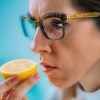 Children often turn off cameras for an online lesson. Especially high school students do that. One student wants to stay in his pajamas, another is not ready to show his room to the whole class, and the third is generally busy with something else and has also turned off his microphone. How does the teacher feel? The teachers told Pravmir.ru how they feel when during an online lesson, without seeing the students’ faces, and how they try to establish contact with the children.
Children often turn off cameras for an online lesson. Especially high school students do that. One student wants to stay in his pajamas, another is not ready to show his room to the whole class, and the third is generally busy with something else and has also turned off his microphone. How does the teacher feel? The teachers told Pravmir.ru how they feel when during an online lesson, without seeing the students’ faces, and how they try to establish contact with the children.
The Main Thing Is not a Camera, but Feedback
Tatiana Mukina, teacher of mathematics, from the town of Bor, Nizhny Novgorod region:
“Situations when students do not turn on their cameras during the lesson happen all the time. This happens especially often in high school. Children say that they either have problems with the sound, or have no camera, or something else.
For those who do not turn on their camera, I ask them to write answers in the chat or send solutions. But discussing and arguing about the camera during the lesson is impossible, there is simply no time for this. In 30 minutes you need to explain something and ask questions, there is no time left to discuss the technical issues.
We cannot apply any sanctions, for example, not allowing those who do not turn on their camera to the lesson. I let everyone in at any time, even 10 minutes before the end of the lesson. You never know what could have happened: maybe they had issues with the Internet, anything can happen, really.
Children do not switch on their cameras for many reasons. High school students do it more often. I think that many are not sitting at the desk with a pen and a notebook at the ready, they can be lying on the couch or doing something else at the same time. I understand that this is possible.
To invent something, somehow persuade, convince them will not encourage them, I think. The most responsible students always answer the questions and turn on their cameras, they are always in sight. And I give an individual task to those who do not turn on their cameras and do not answer the questions during the lesson. You can’t completely ignore it, if there is no feedback.
The camera itself is not important to me, because I still can’t see everyone at once. The lesson goes through the presentation, on each slide we perform some actions and the whole screen is busy, I see only active windows of only those who answer questions. So I can’t see the whole class at once. Therefore, it makes no sense for everyone to be with their cameras switched on at all times. Perhaps in subjects like English, history, and literature, this is necessary, but in mathematics it is not always reasonable.”
I Want Us All to See Each Other
Natalia Volkova, children’s writer, teacher of English and literary creativity:
“I noticed that if the cameras were always turned on during the lessons in the spring, now it is not so. There is a general fatigue and reluctance to get out of bed, to dress up and sit down in front of the turned on camera. Children no longer want to strain themselves, and they do not turn on their cameras.
It’s a strange feeling, of course, when you don’t see the reaction. It is as if you are either talking to yourself, or with emptiness.
If younger children can simply be told to turn on their cameras and they do it, it is more difficult with teenagers. With them you have to maneuver in some way in order to keep their attention. Therefore, I cannot order them to turn on their camera.
Half of the lessons are held in the format when I share my screen and I can’t see the students, in such situations it does not matter whether their camera is on or off. Therefore, I ask them to switch it on when I need to see how they articulate or during group work. And they usually agree. We do not have conflicts about this.
It is more convenient, of course, when their cameras are on, because I can see their reaction. Perhaps this is a subjective perception and a matter of habit, I want us all to see each other. Actually, it would be more comfortable for me.
Even when you are giving a lecture, you want to see some kind of reaction to it, and not just speak to emptyness. Moreover, there is not always a good connection and sometimes I say something, and in response there are black screens and silence, then it is generally not clear whether they heard me or not. You have to periodically stop and say: “If you can hear me, give me a sign, write number 1 in the chat.”
I believe that you need to negotiate with teenagers, the threats will not work with them. You can’t put ultimatums and say: “If you don’t turn on your camera now, leave the classroom.” In response, the student may simply log out. For me, this is not an option, I’d rather turn everything into a joke and find some kind of compromise.”
Fighting for switched on cameras is not about studying
Natalia Smirnova, teacher of Russian language and literature, Moscow:
“Since October I have been working remotely. It is a normal practice for children to not turn on their cameras during a lesson. It is rather an exception when they do.
At first it seemed natural to me that everyone should be with their switched on cameras. I didn’t understand why the students didn’t turn on their cameras. Now I understand, because the children explained it to me. And I myself, after spending more than two months at distance learning, can say that sometimes I don’t want to turn it on either.
On the one hand, it is unpleasant when I see black squares instead of the children. But when I share my screen, I no longer see those who have their cameras turned on, or those who don’t.
I’m not trying to fight this, I think it’s a personal matter. I understand that some children find it uncomfortable to sit in front of the camera all the time.
The teacher should first of all ask himself the question, what is the point of having 25 cameras switched on? Is it to control what children learn?
But it is impossible to control what a child is doing when his camera is on. He can, for example, flip through Facebook, do other things, and not listen to the teacher. And in general, I do not see myself in the role of a controller. A teacher should not be a controller, this is clearly not about the school.”
“I communicate with my images of the children, and not with themselves”
Marina Brenner, history teacher at Solnyshko Russian School, Nice-Strasbourg, France:
“Situations when students turn off their cameras during the lesson happen all the time. When the pandemic first started, it annoyed me. It seemed that this was disrespectful for me as a teacher. And now I am very calm about it.
Of course, I really love to see my students. So it is easier for me to understand all the reactions, and see when something has remained incomprehensible, or, on the contrary, everything is clear and you can go on, and move at a faster pace.
Of course, I would prefer that everyone had ideal conditions, so that everyone could study from home, nothing prevented them from turning on their cameras and microphone, and so on. But in reality, it doesn’t work that way for the whole class to be with their cameras on.
I honestly tell the students that I am very pleased to see their eyes, I really want to see their facial expressions, how they react, but if for some reason some of them cannot or do not want to turn on their camera, I do not insist.
At one school where I work with younger children, we have an arrangement with the parents that they provide the cameras that are on, and usually there are no problems.
In another school, where there are older children, the cameras are mostly turned off during lessons, but the position of the administration is such that all students live under different conditions and the teacher needs to be loyal and support them, and not press them and not aggravate stress. We check the students’ involvement in the lesson not with the turned on cameras, but with the activity they show in their assignments and questions.
I tell my students that I communicate with my images of them, and not with themselves, and if they turn on their cameras, they will help me with this. But usually less than a third of the students have their cameras on during a lesson. The main requirement is that they be present at the lesson. I address them with my voice, there is communication in the chat, they perform tasks, and I understand that they are present in the lesson, are involved in the work, and visually they may not be visible for some reason, for example, they are not comfortable or some domestic circumstance does not allow this. We proceed from the fact that we trust children.
I don’t have any dissatisfaction, or feeling that they turn off their cameras out of spite or on purpose. I believe they would like to do it, but are not always able to.”
Translated by pravmir.com

















